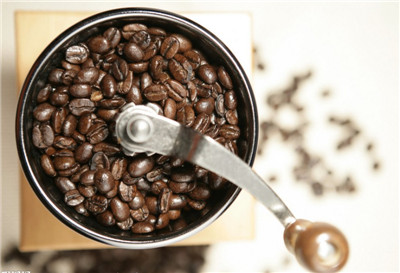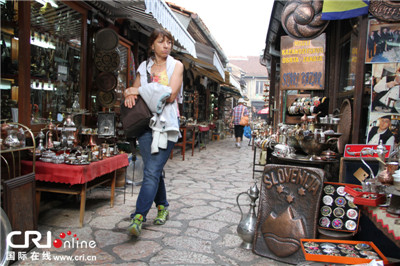(单词翻译:单击)
For the Travel section’s Oct. 19 issue on Europe, writers and editors selected special items to profile from a dozen cities. Below, explore everything from chocolate in Brussels to silk in Florence to design in Copenhagen.
在欧洲版10月19日旅游板块,作者与编辑精选了十二个城市的独特珍宝,下面,我们从布鲁塞尔的巧克力、佛罗伦萨的丝绸到哥本哈根的设计,逐一欣赏吧。

Sarajevo: Coffee Sets
萨拉热窝的咖啡壶
To know Sarajevo, you must understand the importance of coffee. Making traditional kafa (coffee) — introduced here soon after the Ottoman Empire conquered the Kingdom of Bosnia in 1463 — is a process. Grounds are roasted in a dzezva (JEHZ-vah) before adding boiling water. When the froth foams to the top, the rich brew is poured into a small, handleless china cup known as a fildzan (FILL-john), which sits in a copper sheath, or zarf. The world grinds to a halt. Cigarettes are lit. Conversations take hushed tones.
想了解萨拉热窝,你必须了解咖啡的重要性。烹制传统咖啡有一套特定的流程。1463年,奥斯曼帝国征服了波斯尼亚王国,之后没多久,传统咖啡就引进了此地。把咖啡豆放在咖啡机里烤熟,然后倒入开水。当咖啡汁液里的泡沫升到顶部,就可以把浓香的咖啡倒进一只小小的无柄瓷杯,这种杯子称作费尔江(fildzan),平时放在一只叫做扎夫(zarf)的黄铜护套里。咖啡煮好了。香烟点起来了。低沉的交谈即将开始。
The ritual that is Bosanska (Bosnian) kafa is lost on many tourists as they navigate the beehive of trinket-peddling hawkers in the cobblestone alleys of Bascarsija, the Ottoman Quarter. But a trained ear can make out craftsmen coaxing copper into vessels used for preparing and drinking Sarajevo’s beloved beverage.
当游客漫步于奥斯曼街区巴斯卡斯加街巷的卵石路,在密密麻麻的小商贩之间穿行时,他们大都淡忘了波斯尼亚咖啡的烹制仪式,但一只经过训练的耳朵却能够分辨出工匠把黄铜敲制成容器的声音,他们会用这些容器烹制及啜饮萨拉热窝人最爱的饮品。
On Kazandziluk (or coppersmith’s) Street, across from Sebilj, find the wooden fountain in Bascarsija’s main square. Midway down the narrow flagstone avenue, Muhamed Husejnovic sits in his shop, Kazandzijska Radnja (Kazandziluk 18), hammer-pinging coffee sets (around 50 Bosnian convertible marks, or KM, $34 at 1.46 KM to the dollar), as Bosnians have done for 500 years.
在塞比利对面的铜匠大街,在巴斯卡斯加大广场上寻找木喷泉,沿着狭窄的石板路走到一半,就看到穆罕默德·胡塞努维克Muhamed Husejnovic)坐在自家的店铺Kazandzijska Radnja (Kazandziluk 18)里,挥舞着锤子锻造咖啡壶(售价大概50波斯尼亚可兑换马克,或称KM;按照1美元等于1.46KM计算,合34美元),正如波斯尼亚人500年前所做的那样。

“This work is not respected like it once was,” said Mr. Husejnovic, whose family business goes back more than 200 years. “For every 100 cheap coffee sets sold in Bascarsija, I sell one.”
“这种工作不像过去那么受尊敬了。”胡塞努维克先生说,他的家族企业有200多年的历史了。“在巴斯卡斯加,每100套平价咖啡壶里,都有一套是从我这儿买的。”
Walk north, across the square, to another tiny atelier, Manufaktura (Kovaci 28), where the owner and coppersmith Abdulah Hadzic treats visitors to impromptu master classes, explaining how he turns his dzezvas (30 to 80 KM) into functional art. Some are filled with molten lead so Mr. Hadzic can hammer dimples and floral swirls onto their exteriors without compromising their shapes. He removes the lead and sanitizes the dzezva before applying a stove-ready tin lining. For others, he’ll apply a coat of tin outside and in, and engrave through to the underlayer of copper in geometric patterns. “There is no end to this work,” said Mr. Hadzic as he chiseled away.
穿过广场向北走,去往另一个小型的手工咖啡壶作坊(Manufaktura,库瓦西大街28号),店主兼铜匠阿卜杜拉·哈茨克(Abdulah Hadzic)在这里招待游客,即兴讲授大师级课程,演示他是如何将咖啡壶(售价30至80KM)变成功能艺术的。有些半成品内填满了融化的铅水,哈茨克先生就在外壳上用锤子敲出水波或漩涡花朵的图案,却不用改变咖啡壶的造型。他将铅水倒掉,为咖啡壶消毒,最后镶嵌上一条已经在炉中镕好的锡边。至于其他的咖啡壶,他会安上一层锡壳,凿出几何图形的镂空图案,露出黄铜底层。“这活儿永远干不完。”哈茨克先生一边说,一边继续手中的雕刻工作。
Purchase in hand, make your way to Cajdzinica Dzirlo (Kovaci 16; 387-61-159-965), a cafe that serves kafa (3 KM) the old way, in individual-size dzezvas. Then, on a terrace overlooking Bascarsija, fill your fildzan, and heed the words of Diana Dzirlo, the cafe’s owner: “A coffee must take at least half an hour just to sit and enjoy.” ALEX CREVAR
手工咖啡壶买到手了,你可以直奔卡兹尼卡泽露咖啡馆(Cajdzinica Dzirlo,库瓦西大街16号;387-61-159-965),这家餐厅供应的老式咖啡(售价3KM)盛放在单独的容器内。然后在一座能俯瞰巴斯卡斯加风光的露台上,倒上满满一杯咖啡,倾听老板娘戴安娜·泽露(Diana Dzirlo)的盈盈笑语:“一杯咖啡起码得喝半小时,就坐在这里尽情享受吧。”亚历克斯·可瑞瓦(ALEX CREVAR)供稿。


